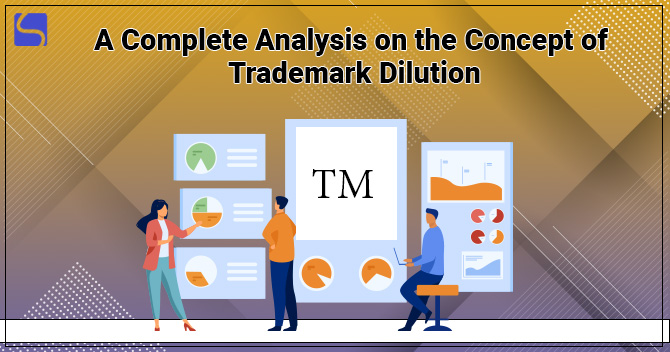A Complete Analysis on the Concept of Trademark Dilution

Karan Singh | Updated: Feb 09, 2022 | Category: Trademark
Trademarks play an essential role in showing the quality of a product or service. A Company or an individual can obtain Trademark Registration as per the legal procedures provided under the Trade Marks Act, 1999. The Parliament of India replaced the Trademark & Merchandise Marks Act, 1958 with the Trade Marks Act, 1999, to provide better protection to the products & services. The Trade Marks Act, 1999 introduced the concept of Trademark dilution. Scroll down to check more about the concept of Trademark Dilution.
Table of Contents
What do you mean by Trademark Dilution?
It’s a form of Trademark Infringement, where the well-known Trademark owner has the exclusive right to prevent others from using their mark. It occurs when an illegal or unauthorised party uses a Trademark in a way that would diminish the Trademark image. Dilution protection is intended to safeguard a sufficiently robust and well-known Trademark from losing its sole association in the public’s mind with a specific product.
There are two different types of Trademark Dilution:
- Blurring: It occurs when the uniqueness of a well-known Trademark is diminished due to a Trademark created by an illegal party. For instance, if a business or a company uses the AMUL mark on kitchenware, customers may begin to link the well-known AMUL mark with the kitchenware brand and this can lead to affecting the brand image of AMUL destructively.
- Tarnishing: It occurs when an individual or a business illegally uses a mark in an inappropriate, violent, or absurd context. For example, if anyone sells undergarments under the BENZ mark, the use of the BENZ mark on undergarments can blemish the name of the renowned manufacturer of the finest engineered cars BENZ.
The act of Trademark Dilution by way of tarnishment is always regarding robust, recognised, and well-known Trademarks. This has the effect of weakening or reducing the strength & recognising the Trademark value. There is no need to set up the likelihood of confusion as to the affiliation, source, and connection. This is so as some capable purchasers are confused as to source/affiliation while others may not.
The Doctrine of Trademark Dilution
The Doctrine is unique and independent. The basic object of the Doctrine is that there is an assumption that the pertinent customers being to link the Trademark with an original & different soured of products & services. The Doctrine of Trademark Dilution leads to a principle in Trademark Law that safeguards a Trademark from any disintegration. As per the Doctrine, to set up the Dilution, the petitioner has an obligation to prove that:
- The violator or infringer has used a mark or logo that is clearly identical to the well-known Trademark to monetise from the goodwill & image of a known Trademark;
- The economic damage has been done by falling the value of the famous Trademark.
Doctrine of Dilution of Trademarks in India
The Dilution word has not been specifically defined in the Trade Marks Act, 1999[1], but Section 29(4) of the Act, states the meaning of Trademark Dilution. This Section tells that if a Trademark has an image in India, then the use of mark identical with/similar to it; even the products or services which are dissimilar, constitutes infringement or violation as such use without due cause, would take unfair benefit of a reputed Trademark or harm its unique character. So this Section assumes that a registered Trademark is violated by marks which:
- Similar to a registered Trademark already having an image in India and used concerning products & services which are not similar or identical to those for which the Trademark is registered;
- When any individual takes undue benefit of a renowned mark or mark having a unique character.
What are the Exceptions to Trademark Dilution?
There are some conditions under which the violating mark shall not be actionable as Dilution. This comprises conditions where the mark is used to parody, commentary, criticise, entertainment purposes, and educational purposes. Such cases may come under the vision of expressive or nominative fair use; therefore, they cannot be considered Trademark Dilution. Moreover, promotional activities that permit customers of a brand to compare products or services are allowed and will not be actionable as Dilution.
Mehtab Ahmed vs Caterpillar Inc. and Ors Case
In this case, the plaintiff or petitioner filed a lawsuit for a permanent injunction against the defendant for selling various articles comprising footwear, using the similar Trademark CATERPILLAR and CAT. The Delhi High Court ordered in favour of the plaintiff and specified that “So far as the Doctrine of Trademark Dilution is concerned, it is a unique and independent Doctrine. The fundamental object of this Doctrine is that there is a presumption that the pertinent customers start connecting the Trademark with a new & different source. It partially affects the descriptive link between the prior mark of the user and its products. In other terms, the association between the products and the marks is unclear. It amounts to decreasing the force or the Trademark value and slowly matches the commercial value of the marks in parts. Such a kind of Dilution is not a fair practice that is expected trade & commerce.
Conclusion
The power discussed on the well-known Trademark owner is known as the concept of Trademark Dilution. This philosophy will help in protecting the company’s image and prevent illegal acts that may happen over time. Such known enterprises contribute to the country’s GDP, and it is the responsibility of the administration to defend them against unfair competition and other misleading practices. Section 29(4) is a remedy that exists in addition to breach action. The idea of Dilution is based on the courts’ authority and the conditions laid down by them. To prevent confusion, if a Trademark fails to pass court standards, it is not certified to market in the marketplace.
Read our Article:What Are The Different Ways To Monetise A Trademark? – Overview














